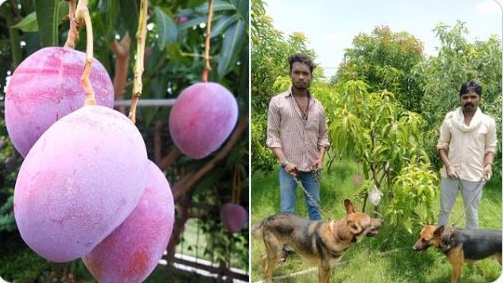This is a Japanese mango called “Sun Egg”, which costs more than $ 50 each and is considered to be the most expensive in the world.
Two farmers in India have planted two trees worth of gold on their land. Rani and Sankalp Parihar, unknowingly planted a strange mango, which became the most precious in the world. Now, to protect this valuable fruit from possible theft, they had to employ private security and even a team of guard dogs.
Both were originally from Jabalpur, a state in the central Indian state of Madhya Pradesh. One day they decided to go to the next town to get seeds for their garden, they met a young man on the train and they showed him two trees with specific characteristics.
“He gave me two saplings and asked me to take care of them like our children. We planted them in the orchard not knowing what kind of mangoes it would produce,” Sankalp Parihar told the Indian media Hindustan Times.
You can read: Anthony Todd, “loving father” killed his three children and wife for a “petty” reason
The worker said that when the trees began to bear fruit, they realized that they were very different than anything they knew about mangoes. The newly emerged fruit was so attractive that, without recognizing it, Parihar named it Domini, the name of his mother whom he wanted to respect.
A couple in Jabalpur, Madhya Pradesh, have tightened security at their orchard to protect their valuable Miyazaki mango varieties. Photo: Illustrative and Commercial Image / https://bit.ly/3d1tLwD
“Then we explored that genre and found the real name, but for me it would still be Dominion,” Sankalp Parihar said.
They later discovered that the strange fruit was called miyazaki and was made in Japan. Also known as the “egg of the sun”, this desirable fruit is considered the most expensive mango in the world and is priced at more than $ 50 per unit in the Japanese market.
The mango is ruby red in color and very sweet in taste, which is considered a luxury in other cultures. All this information triggered the alarms of the farmers, who imagined that having such a valuable tree on their land would give them problems.
We recommend: Raped, beaten, and forced into prostitution: A French woman on trial for murdering an executioner tells of her “hell”
A valuable commodity in the Parihar land spread like wildfire in the region and last year, a thieves broke into their garden and took two precious “sun eggs” from there.
Sankalp added that four guards and six dogs have been hired this year to protect the rare trees and seven mangoes that have grown so far.
The farmers told the aforementioned Indian media that they have been given enough money for the fruits but now they do not want to sell them to expand the Miyazaki mango orchard.

The Japanese type Miyazaki, also known as the “egg of the sun” in Spanish, is considered one of the most luxurious gifts in Japanese countries. Photo: Illustrative and Commercial Image / https://bit.ly/3d1tLwD
“Mango growers and lovers of this fruit contacted us, a businessman offered us 21,000 baht (US $ 280) for a mango, and a jeweler from Mumbai said he would pay for what we quoted, but we made it clear to them that we would not sell them. We are going to use fruits to grow more plants, ”said Rani Parihar.
Miyazaki mangoes were first grown in 1984 in a Japanese city of the same name. Currently, it is considered one of the most valuable fruits on the planet and is found only in countries such as Bangladesh, Indonesia and the Philippines.
Tree growth requires a warm climate and long periods of sun to reach the fruiting moment.
This particular handle has a ruby red color and egg-like shape, which gives it its name. According to India Today, they weigh 350 to 900 grams and contain 15 percent more sugar than other varieties of the same fruit.

“Internet addiction in terminals. Award-winning beer expert. Travel expert. General analyst.”






More Stories
Cleaners at prestigious UK girls’ school win pay and conditions dispute
Soybeans fall in Chicago, with expectations of a good harvest in the US
Support planned for UK households struggling with winter energy bills